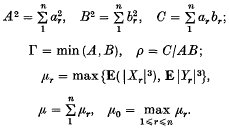No CrossRef data available.
Published online by Cambridge University Press: 24 October 2008
Our object here is to refine the theorem proved in (3), and we use the notation of that paper. Let Z1, Z2, …, Zn, where Zr = (Xr, Yr), be independent random variables in two dimensions with zero first-order moments and finite third-order moments; and et the covariance matrix of Zr be

We write

Let  (x, y) be the distribution function of the sum
(x, y) be the distribution function of the sum  and let
and let  (x, y) be the normal distribution function having the same first- and second-order moments as
(x, y) be the normal distribution function having the same first- and second-order moments as  (x, y).
(x, y).